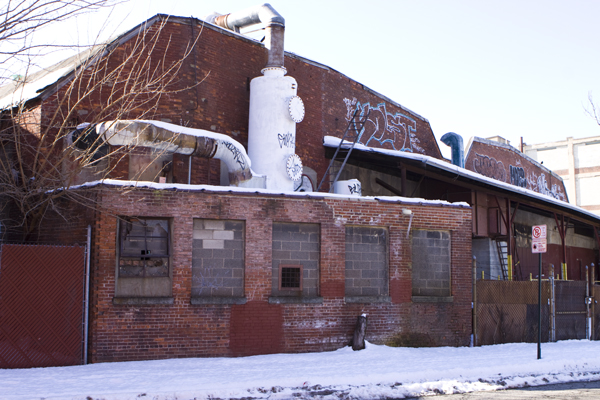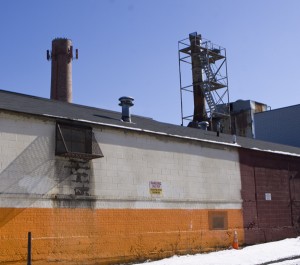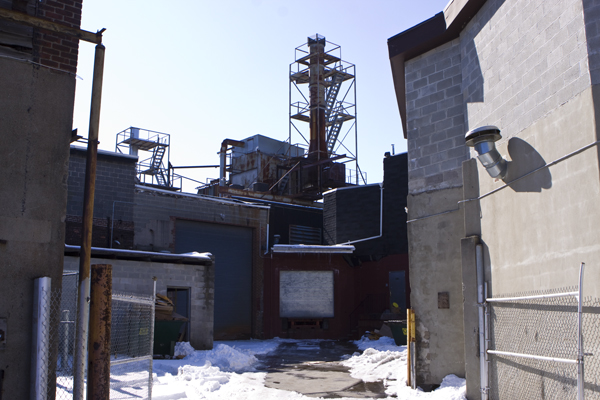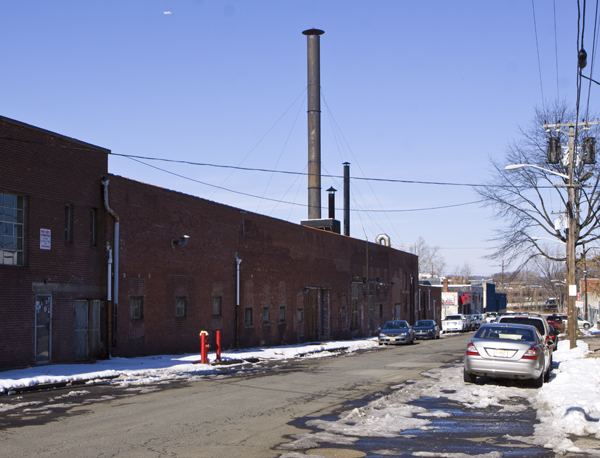
Galaxie Chemical, Paterson, NJ. Suspected source of high local levels of dichlorobenzene.
The NJ Business and Industry Association is pushing an Op-Ed whining about the costs of air pollution permits at DEP – and using this as a sham “horror story” argument to support Governor Christie’s efforts to rollback NJ’s strict environmental regulations. Kirschner whines:
Permits are also far more expensive and difficult to obtain in New Jersey than other states. Take air permits, for example. For the largest facilities, if you’re getting one in North Carolina, the maximum renewal fee you pay is $6,500 every five years, and the permit application is about 40-pages long. That sounds like a lot, until you get to New Jersey, where the same permit could cost as much as $50,000 and require a 600-page application.
But the real problem is that current air permits are not strict enough or enforced by DEP (and NJ’s air is FAR more polluted than North Carolina’s which is why NJ must set tougher pollution control requirements).
Failure to fully implement and enforce air laws is one reason why air across the entire state of NJ exceeds EPA cancer risk standards by hundreds of times for 18 toxic chemicals regulated as “hazardous air pollutants” (HAP’s) under the federal Clean Air Act (see: EPA “National Air Toxics Assessment”). Most recently, this was demonstrated by an EPA funded air toxics study in Paterson.

Industrial smoke stacks in Paterson NJ.
Under federal law, industrial facilities that emit HAP’s must install “maximum achievable control technology“ (MACT) and NJ DEP must issue permits that mandate MACT. But scores of NJ industrial facilities do not comply with current federal MACT permit requirements and DEP has not enforced those standards in air pollution control permits for all facilities subject to MACT requirements.
Under NJ’s more stringent State Air Pollution Control Act, those facilities must install even better pollution control devices that reflect “advances in the art of pollution control“, known as “state of the art” or SOTA.
Let me explain the impacts and public health stakes of enforcement of MACT and SOTA.
During the Paterson air toxics study, high levels of p-dichlorobenzene, a suspected human carcinogen, were discovered. In attempting to track down the source of this chemical, DEP scientists focused on Galaxie Chemical. Here’s what DEP scientists had to say about Galaxie in a 8/23/07 email (pictured above):
Linda – Here’s what I found about 1,4, dichlorobenzene. It looks like the possible suspect could be Galaxie Chemical, which is less than 1/2 mile and just north of the C monitor. Their inventoried emission rate most likely will not account for your high numbers therefore it may be a situation where the company is in violation of their permit. We did not visit Galaxie, we did do a drive by with Enforcement and the place looked old and dirty.
So, we ask Mr. Kirshner of NJBIA: do any of these Rube Goldberg operations look like SOTA or MACT to you?
Would you like to live next door to these facilities?

air pollution control devices in Paterson, NJ. Is that SOTA or MACT?
Do you think any facilities like this are being built and are operating in North Carolina? (North Carolina polluters are subject to federal MACT requirements, just as in NJ).

Industrial air pollution in Paterson NJ. MACT compliant? SOTA?
So here’s an open challenge to NJBIA and NJDEP (and some enterprising investigative journalist or citizen activists out there):
1. provide a list of NJ’s industrial facilities subject to federal MACT requirements. Then tell us how many of those facilities have MACT standards in permits. Then of those facilities with MACT in permits, show us the list that have MACT installed and are meeting MACT requirements.
2. provide a list of NJ facilities that go beyond MACT to attain the NJ APCA requirements for SOTA. This will answer the question of whether NJ DEP is really protecting public health by mandating the use of the more stringent state SOTA standard, as compared to federal minimum MACT standards. The answer to this question is especially relevant right now, because Christie’s Executive Order #2 seeks to roll back stronger state standards to federal minimums.
3. Put all this emission inventory and air permit status information on a map so the communities that host these facilities can be aware of the health risks they face and fight back.
end

Pingback: WolfeNotes.com » DEP Protecting Polluters, Not People
Pingback: WolfeNotes.com » Christie Regulatory Moratorium Blocks Major Environmental Protections
Pingback: WolfeNotes.com » Year of Rollback, Retreat, and Appeasement – Christie Worse Than Whitman 1994
Pingback: WolfeNotes.com » Low Hanging Fruit in Pollution Control Remains Unregulated
Pingback: WolfeNotes.com » NJ Gov. Murphy Faces A Huge Challenge Reversing Christie Environmental Dismantling And Restoring DEP Integrity and Leadership
Pingback: WolfeNotes.com » Forty Policy Questions For Gov. Murphy’s DEP Commissioner’s Senate Confirmation Hearing
Pingback: WolfeNotes.com » Murphy DEP Renews Air Pollution Permit For Major Fossil Gas Power Plant – Permit Has No Limits On Greenhouse Gas Emissions
Pingback: WolfeNotes.com » Murphy DEP Issuing Permits That Allow Industrial Polluters to Emit Millions Of Pounds Of Carcinogenic Hazardous Air Pollutants Without Adequate Consideration of Health Impacts or Community Involvement
Pingback: WolfeNotes.com » Now Is the Time To Make Real Demands On Environmental Justice Legislation
Pingback: WolfeNotes.com » NJ DEP Submits Clean Air Act Ozone Plan To EPA For Review And Approval – Who Knew?
Pingback: WolfeNotes.com » Is DEP’s Environmental Justice Advisory Council On A Wild-Goose Chase?
Pingback: WolfeNotes.com » Murphy DEP Denial Of Climate Petition Exposes The Sham Of Murphy’s Climate Rhetoric
Pingback: WolfeNotes.com » Murphy DEP Issues Another Climate Science Report – And Does Nothing
Pingback: WolfeNotes.com » Murphy DEP Proposes New Air Pollution Cancer And Health Risk Screening For Polluters – Ignores Cumulative Impacts And Environmental Justice Law